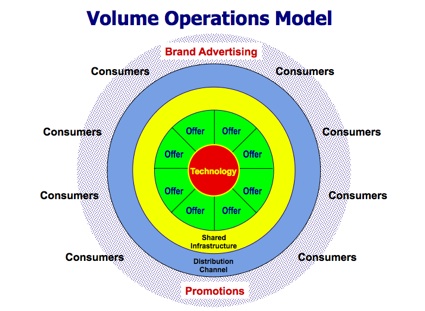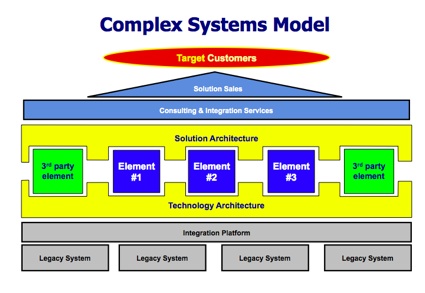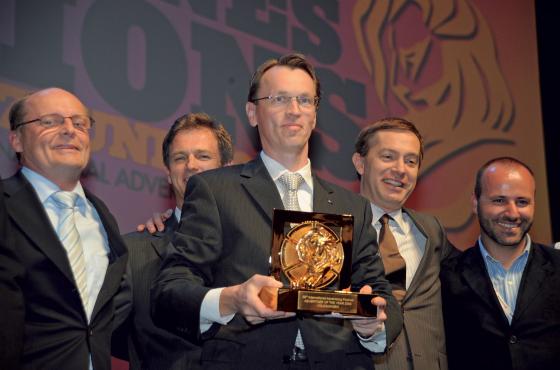 |
|
StefanL, 13.09.09, 19:43
On last Friday an associated person drew the editors' attention to two things. Quoting Peter Drucker with "The purpose of a business is to create a customer and keep him." is a reminder anyone in business should pronounce once in while.
The pointer to Dealing With Darwin was new to us. Dealing with Darwin is a relatively new and rather interesting business economics pattern book published in 2005 by Geoffery Moore .

Let us just mention that we completely agree with Mr. Drucker in the assertion quoted with respect to business as an organizational form.*
In his book Mr. Moore suggests there are two different basic business model architectures for successfully handling innovation and the task of creating and keeping customers, calling them the Complex Systems Model and the Volume Operations Model. Mr. Moore also recommends not to mix these architectures:
The two cannot and should not mix, or share best practices. Businesses with one architecture should not covet the benefits of the other.
A first line explanation
Volume operations customers, like individuals buying coffee, sports ware, mobile music players or enterprise units buying furniture, multipurpose office software or cars, require an easy-touch, a few-sizes-fit-all approach, where customization, if available at all, is in DIY or small business personal services form.

Volume operations start with a base technology. This creates a portfolio of offerings which spread through a continuum of channel operations to a potentially huge base of customers. If the potential is reached then the buyers generate the cashflow as trickles of small transactions that unite to a mighty river at the supply side.
Sony, Volkswagen, Apple Records, Apple Computer, the application arm (but not the server software arm) of Microsoft and many regional food, say for example local cheese, companies are good examples for this business model. These companies deal in standards. Edison, Bell and Ford are famous implementors.

Complex systems customers on the other hand, like, for example, an enterprise buying a new overall IT architecture and implementation of their business processes (say Allianz) or a multinational buying cross-country, cross-media, cross-targetgroup promotion (say Coca Cola) or individuals buying a new home for their family, require an intense-touch, high-customization approach.
As we can see in Mr. Moore's diagram, the complex systems model necessitates a solutions model which involves an integration platform over legacy infrastructure elements, all bunched and connected by a technical architecture layer, a mixture of own and third party modules, a second architecture layer that maps the bottom of the system to the customer’s needs and tastes. The complexity of this alone is often too much for the customer and this in turn opens the opportunity to offer consulting and integration services as an icing on the cake.
NASA, CapGemini, Siemens, WPP, Oracle, SAP, Bouygues and many local business technology integrators are good examples for this business model and its architecture. The model does not scale infinitely but does so pretty well.
What the business architectures have in common
Everybody knows, companies have to be profitable to stay in business. We now need to return to Drucker as an unsuspicious source for the assertion that profit is not the goal of business, which is to “create and keep a customer”. Profitability is a constraint. It is needed to manage risk, crisis and survival.
How the business architecture requirements differ
Preliminary Conclusions
We now start to see why Mr. Moore so adamantly discourages the mixing of both business architectures. We could give lots of examples, positive and negative. Lets be content with 3 or 4. After 25 years in the business and great successes IBM got rid of its PC product line. Siemens never really succeeded in electronic volume operations products. Oracle although trying hard and repeatedly was never once able to successfully develop, ship or sell mass consumer products.
All of these examples are very well managed companies and have been generally successful over many years. The other way round mixing business was more rarely undertaken. Apple would be a modest example. While maybe they have - after many crises - mastered the volume model better than anybody else, whatever they did in the server, network, management and IT services area was ridiculous and doomed to fail. Amazon on the other hand, who seem to be very near to the mass consumer market is in truth coming strictly from complex system for logistics, distribution and commerce of everything and with only a very small unit to design and market Amazons own products, seems to handle the complex systems architecture requirements quite well.

Mass media, a practical and fundamental violation of the underlying principles
Now traditionally, mass media, as the name suggests and considering their main product, found themselves quite naturally in the volume operations architecture. All customers of a newspaper read the same newspaper that morning, evening and the next day. All viewers of a movie or television entertainment program used to watch the same story unfold on the silver, phosporized or LCD-lit screen. In traditional newspapers, pay TV, pay radio (including public service broadcasters), paywall websites and apps subscription fees and the sale of single media pieces still provides for a large parte of the revenue the but in free to air privately owned radiostations, TV-Stations, free newspapers and websites ad slots are nearly the only things that move money in the direction of the owner.
And so for many of these media companies money from commercials was a lot more important than sales of their media pieces, editions and subscription, which gave them a feeling they had a fundamentally superior model because price set no limit to the size of their audience which in turn became the product for their real customers, the media agencies which in turn handled the volume operations business that so desperately needed segments as large as possible of the selected target groups for their very shiny and expensive commercials to operate upon.
Until digital came along no one even dreamt of customer based ad slot customization. As a customer you'd book that slot or space, send in your hopefully sexy spot, poster or 4/4 display ad and that was that. National and regional selling was a lot cheaper and easier than what Coke and Apple had to do when conceiving and booking global campaigns.
There is a large difference between media pieces on one hand and Coca Cola, Red Bull and iPhones on the other hand though. The daily products and even building blocks (clips and articles) may have uniform rules but are still handcrafted by teams consisting of artists of different talent and performance, thus leading to the above mentioned nontransparent cost structures typical for complex systems businesses. Modern radio with its playlist dominance and product elements that can be used for many weeks and even years and online-media with its larger shares of newswire content have mastered that problem just ab bit better than TV and newspapers.
On the marketing side, once physical production machinery and transport were efficient enough, low implementation and distribution cost expanded the reach to practically the limits of language comprehension. In entertainment, without the need of speed in news content, it was even easier to consider transnational markets. Translation and overdubbing enlarged markets to culture comprehension sizes.
The complication with the three classes of mass media's customers
On one hand there has been the necessity of daily handcrafted production from the start of the mass media business model in about the 1830ies. To make things worse, the better the writers, photographers, camera operators and directors you employ the less you will be able to make them uniform and daily riable. You need those qualities though to make a difference in many market segments of the media industry. Automization, at least for commodity media pieces like sports and weather reports seem to have come a long way, but too much of it brings the danger of boredom and loosing any differentiation. For high class pieces and series computers support a lot more processes but you still need talent for which the competition is fiercer than ever.
But the real complications mass media are confronted with are set by the two classes of customers, the masses in mass media who really need the volume operations approach in lots of ever more segements and those who pay much larger sums in fewer bills, are the buyers of the eye pairs product and, accordingly, do not request the easy-touch, a few-sizes-fit-all approach of volume operations but require the intense-touch, high-customization approach of the complex system architecture.
The second class of customer is a complex mix of product promoting companies and their advisers and consultants, a sector which the media companies call the advertisement industry. The product these customers want to buy is increasingly complex. Though it is constructed out of rather uniform and simple mass available byproduct elements of mass media (time and space slots for ads), the form and set into which these elements are combined tends to be ever more complex. Those customers and the associated offers and sales stuff, if only for the complex psychology involved, belong to the complex systems architecture.
A third class of customers one are political elite groups which are bound together with media people, especially news people through a complex reciprocal interest. They also do not interact with media through market and business principles but through reciprocal interest exchanges. Quite a lot of investigation has been directed at the contradictions created by the often differing interests and tastes of the second and the third group of complex customers. The moment the second and third group require to much attention from media managers you can be sure the first and most important audience group gets bored and goes somewhere else. Brings you into a defensive vicious circle.
The troubles generated by the two different business architectures can be thoroughly felt every day but have been largely overlooked by media science and model abstraction as far as we can see. The troubles also have been smeared over a bit by the fact that large intermediate groups act in the field with a strong pretension to be able to reconcile those needs and tastes. This pretension is the ground and water they swim in. No figure, nothing to be seen. Just feelings of the participants. From the 80ies to the change of the millenium the advertising industry led the way to ever greater glory. Now they are on the defensive and do not stop to commit blunders over and over. 30 second spots before the audience can see a 30 second video. Booking youtube ads that practically every user clicks away. Booking ads that are surrounded by 4 other moving ads. Only crying, no sexiness, no attraction. But large report with figures in the millions that no one understands. Digital mad cow disease everywhere.

The Provisional Diagnosis
Let us pause here and assert that mass media companies, by their double basic business model architecture fundamentally violate one important rule (Do Not Mix!) explained in Moore's "Dealing with Darwin".
Go on to part 2 of this series
Some necessary philosophical clarifications
We agree with the Peter Drucker on the purpose of business. We also agree with his well-known assertions indicating that innovation and marketing are the only two processes that are really important to reach this goal. This agreement is given inside a preliminary and fictional agreement that business is a good and important way to do things, if not everything.
The last assertion has to be called a fictional agreement, because a practical acknowledgement that business is a field and form of action that needs to be handled under the given circumstances does not provide for long term inner appreciation and full recognition that business and markets are the best form to do ever more stuff in this world.
We also believe that there are many things people can do and did actually do that are stupider and more outdated than doing business. The comparison with those things still makes business look like a good thing to pursue. It also makes suggestions of past and present leaders to carry on with it and do ever more of it look like a sound suggestion (compared to, say, creating peace and well being for everybody by inventing and executing a "culture revolution" as has been empirically and sadly tested in the people's republic of China and afterwards corrected to "doing business" by Mr. Deng).
Correctly understood, this comparison only ascertains that business is a better thing to do than many other things. It does not sufficiently ensure that business is a real good form and field to realize the human potential for every action and interaction. "Better" simply does not of itself guarantee "Good".
Still, doing business and going to markets ist a good pattern for quite a lot of human activities but for others they are a horrible way to conduct them. For example sex and love. At least large parts of the individual an mass communication might be something important that business and markets cannot easily provide if no special conditions prevail. This has to be considered. If it be so it is not a problem that small band aids can remedy.
If local people can have no good professional role in mass media anymore, half the talent will move the world centers of money and power and the other half will have strange ideas. The social fabric starts to wear thin. We will see these effects become more grave still. There is no alternative but pushing against the trend.
Quote Collection Websites normally carry other Peter Drucker sayings like "Management is doing things right; leadership is doing the right things. " and "Most of what we call management consists of making it difficult for people to get their work done."
We agree with these two statements. With this agreement frameworks for deciding what the right things to do are and what the wrong things to do are, come into play. All large frameworks are really hard to tackle. Nevertheless, business is a field of action that, for the time being, as we said, still has to be handled. Seriously. And here at tinytalk plc. we frankly have nearly no idea for how long still it will and into what it shall transform in the future.
|
|
 |
last updated: 15.08.25, 06:48
Youre not logged in ... Login
 ... antville home
Terms of Service
About us / Imprint
| November 2025 |
|---|
| So. | Mo. | Di. | Mi. | Do. | Fr. | Sa. |
|---|
| | | | | | 1 | | 2 | 3 | 4 | 5 | 6 | 7 | 8 | | 9 | 10 | 11 | 12 | 13 | 14 | 15 | | 16 | 17 | 18 | 19 | 20 | 21 | 22 | | 23 | 24 | 25 | 26 | 27 | 28 | 29 | | 30 | | | | | | | | August | | |
    I totally agree
mit der Meinung, dass das Hemisphärenmodell überholt ist.
Die mediale Lust am Untergang hat wohl ein rational kalkulierendes Element auf der einen und massenpsychologisches Element auf....
by StefanL (12.07.25, 21:26)
D'après ce que je vois
vous avez tout à fait raison, Mr. Tobi.
by MaryW (01.03.25, 08:34)
...
La crisi consiste appunto nel fatto che il vecchio muore e il nuovo non può nascere: in questo interregno si verificano i fenomeni morbosi piú....
by tobi (28.02.25, 16:22)
...
Haschimiten-Familie
Vater:Husain ibn 'AliEmir von Mekka von 1908 - 1916König des Hedschas von 1916 - 1924
Sohn Faisal:Verhandlungsführer der "Araber" in Paris König des Irak von 1921....
by StefanL (19.01.25, 06:26)
Ich habe eh
einen Esseh über den Kulturpessimismus, der ja grundlegend mehr reaktionär als konservativ ist, in Arbeit. Wird aber noch dauern.
by StefanL (10.01.25, 23:50)
Jaaa!
Ich geb ja gerne zu, dass der Neid aus mir spricht. ;-)
by StefanL (10.01.25, 23:46)
...
Aha soso ein Professor h.k. (honore kurza).
by tobi (10.01.25, 23:30)
Woher kommt diese Lust am Untergang?
Friedrich Sieburg kommentierte »die Tendenz der Medien, unentwegt den Weltuntergang durch einen Atomkrieg vorauszusagen als weinerliche, kaum zu ertragende Geschwätzigkeit. Sie sei auch deswegen absurd,....
by tobi (10.01.25, 19:18)
Read the books,
watched the series for a while. Got distracted then. Did NOT buy the T-Shirt. Interesting problem. Thanks!
Slice, slice, very slice. Thank you for not killing....
by StefanL (06.01.25, 11:39)
...
Slice, slice, very nice.
by tobi (05.01.25, 23:31)
...
😻
by tobi (18.12.24, 12:27)
We could just barely
keep the censor's office and the press team of the president-elect from intervention but here are our apologies and our thanks for these valuable hints....
by MaryW (17.12.24, 23:37)
...
The (correct) first name of Mr. Zelenskyj is the Ukrainian Володи́мир, not (of all things) the Russian Влади́мир 😿
Second name is Oleksandrovych.
Ложка дьогтю у бочці....
by tobi (16.12.24, 19:15)
Du hast recht,
Universal-Genies brauchen wir echt keine mehr. Ich wollte eh nur sagen:
Things are going to slide, slide in all directions.
Won't be nothing, won't be nothing you....
by MaryW (31.10.24, 23:13)
...
Hm. Ich glaub, da gibt es schon noch einige Kandidat*innen. Mir fällt spontan Lisz Hirn ein. Ich fürchte nur, die schaffen es nicht mehr, so....
by tobi (03.10.24, 19:21)
Das sind
wirklich die allerletzten, diese Streberschweine. Aber sonst auch.
by StefanL (18.09.24, 08:42)
Es gibt sogar
Verbrecher, die das ganze WE zusätzlich durcharbeiten, um Pegelkarten zu bauen. Das sind dann die allerletzten.
by gHack (17.09.24, 18:56)
Geändert
Inzwischen hat Herr Fidler den Fehler erkannt und korrigiert sowie sich inzwischen bei den LeserInnen entschuldigt.
Nur damit das nicht untergeht. Wir haben hier in der....
by StefanL (21.02.22, 09:17)
There has been evidence
that the important and successful ideas in MSFT - like licensing the Unix source code in the 70ies and learning from it and licensing QDOS....
by StefanL (02.01.22, 11:18)
Now
I think I maybe know what you meant. It is the present we know best and the future we invent. And history is mostly used....
by StefanL (02.01.22, 09:51)
???
Hey, it's just a phrase wishing to convey that you're always smarter after the event than before it.
by StefanL (28.12.21, 07:35)
Addendum
Oracle is now mentioned in the English Wikipedia article on teletext and even has its own article here. Electra has one too.
by MaryW (22.12.21, 07:11)
We have grossly erred
At least in point 5. We thought, people would have come to the conclusion that permanently listening to directive voices as an adult is so....
by MaryW (21.12.21, 07:42)
Did not want to spell the names out
Ingrid Thurnher should have been easy, as she is pictured in the article. Harald F. is an insider joke, the only media journalist in Austria,....
by StefanL (19.12.21, 08:45)
...
with four letters it becomes easier though i am not sure with hafi… anyhoo, inms guessing acronyms or whatever this is.
*it’s not my steckenpferd
by tobi (24.11.21, 20:49)
  |










